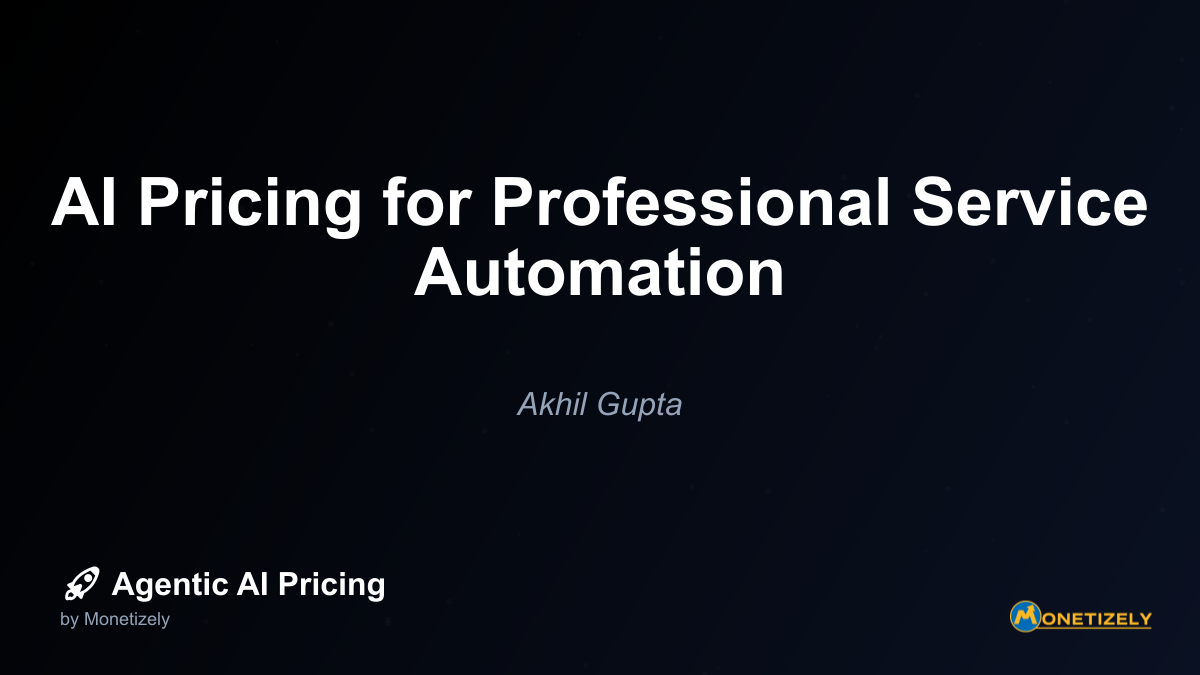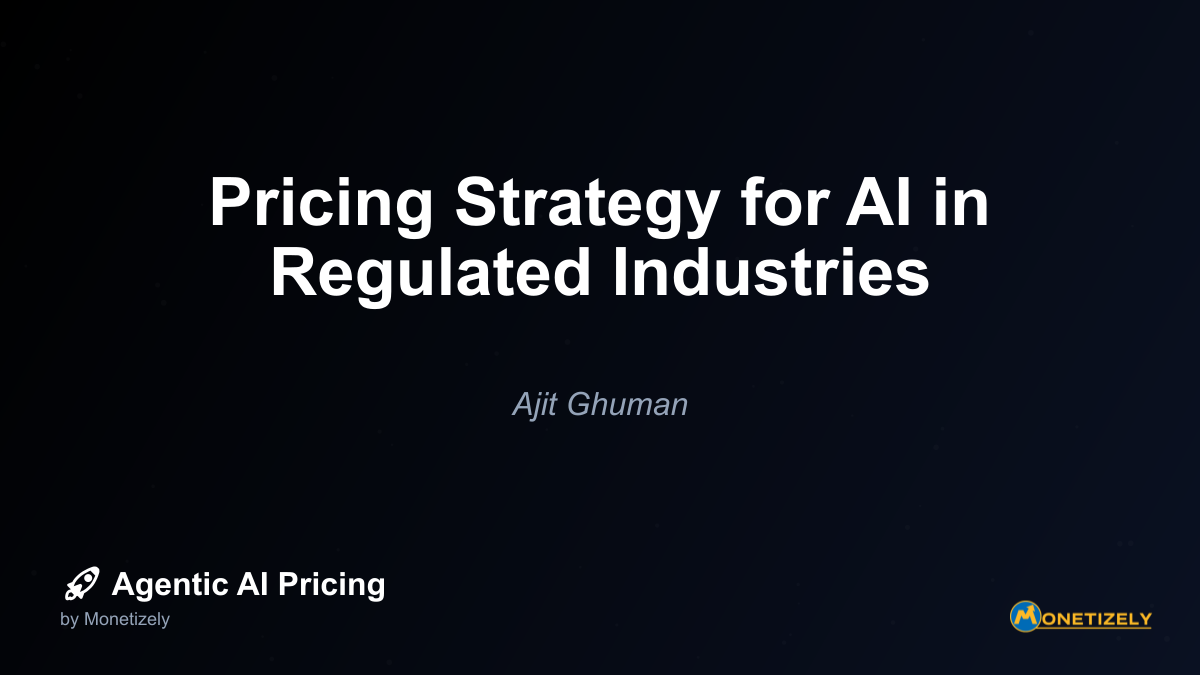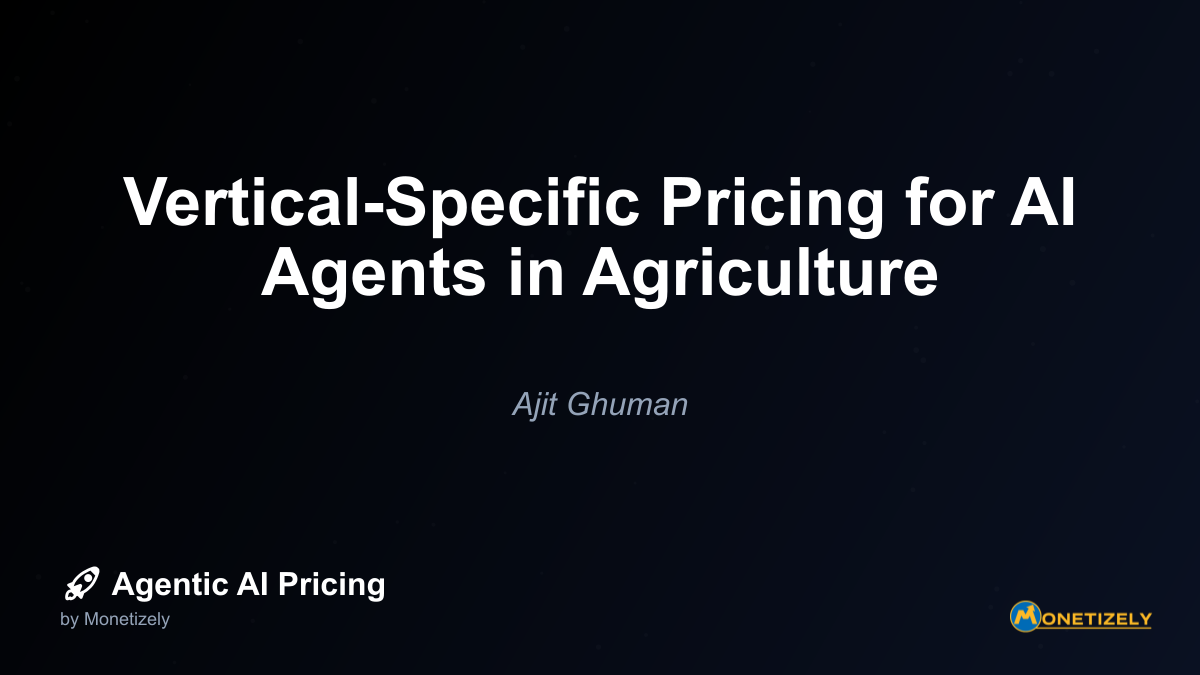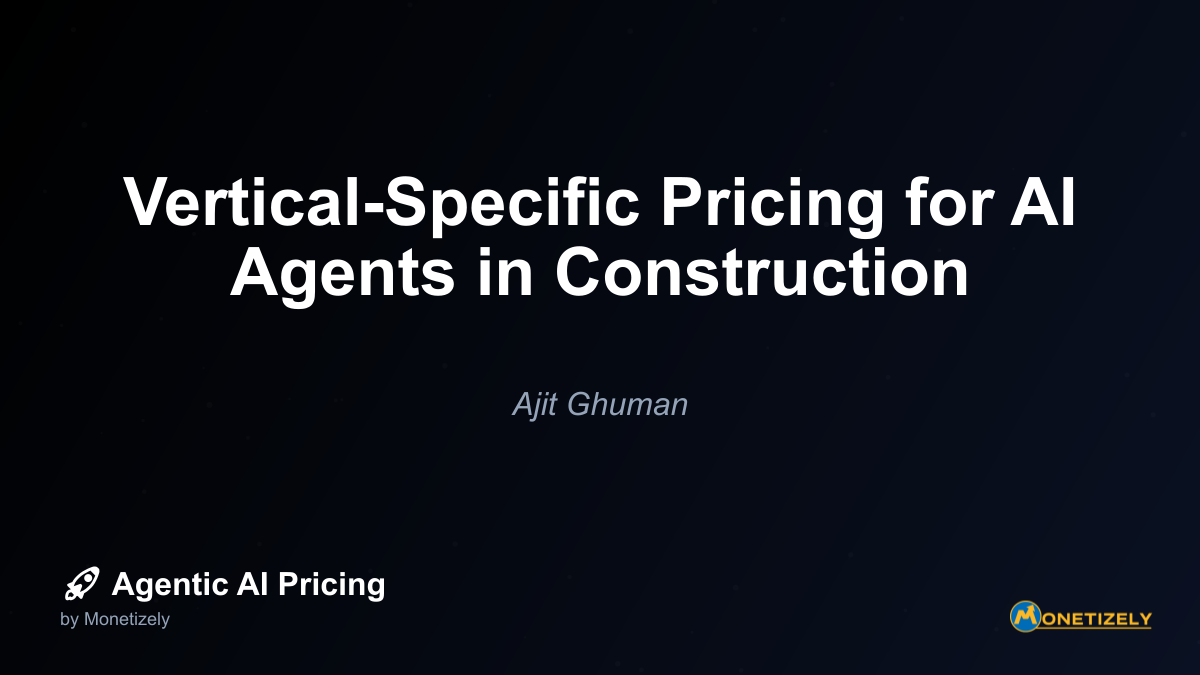· Ajit Ghuman · Industry-Specific · 13 min read
Vertical-Specific Pricing for AI Agents in Media and Entertainment
AI and SaaS Pricing Masterclass
Learn the art of strategic pricing directly from industry experts. Our comprehensive course provides frameworks and methodologies for optimizing your pricing strategy in the evolving AI landscape. Earn a professional certification that can be imported directly to your LinkedIn profile.
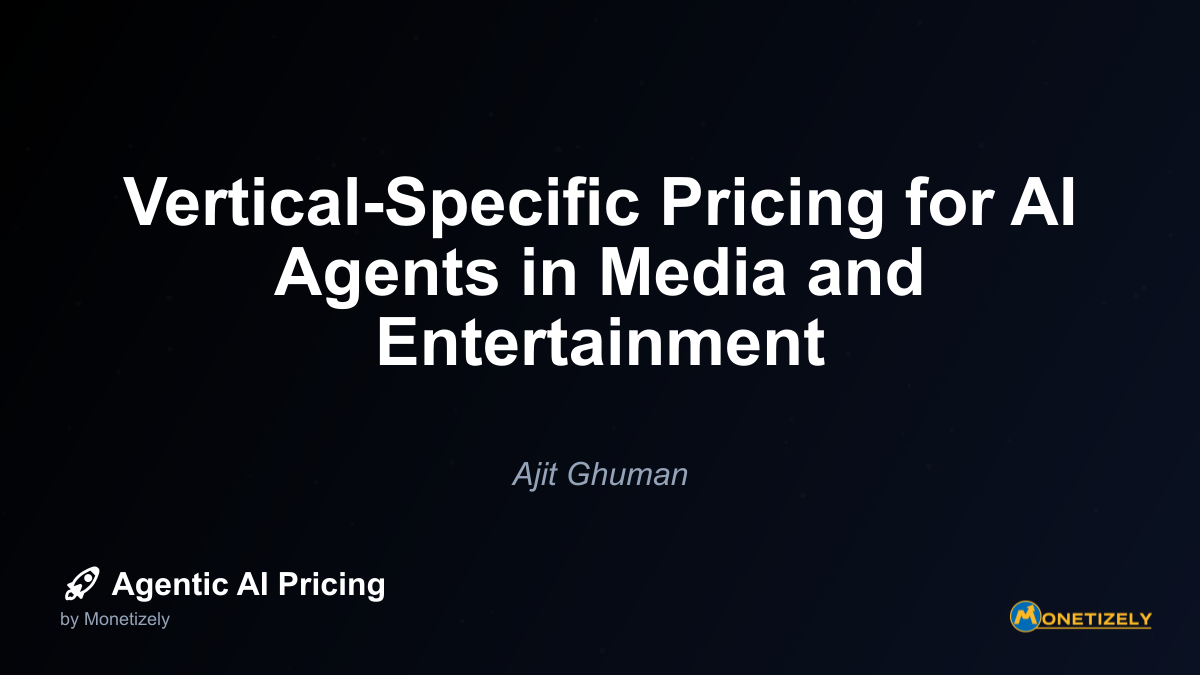
In the rapidly evolving media and entertainment industry, AI agents are revolutionizing how companies create, distribute, and monetize content. The strategic implementation of vertical-specific pricing models for these AI applications has become a critical competitive advantage. This deep dive explores the nuanced approaches to pricing AI agents in content creation, recommendation engines, and audience analytics within this dynamic sector.
The Evolving Landscape of AI in Media and Entertainment
The media and entertainment industry is experiencing a profound transformation driven by artificial intelligence. From automated content generation to hyper-personalized recommendations, AI is reshaping how media companies operate and deliver value to consumers. According to recent market research, the AI in media and entertainment market is expanding rapidly, with forecasts showing a CAGR of 8% to 12% through the 2020s, with projections for the market to reach between USD 11 billion and USD 78 billion by 2033, depending on segmentation and regional growth.
This growth is fueled by the increasing adoption of AI across three primary domains:
- Content Creation and Production: AI-powered tools for scriptwriting, video generation, animation, and music composition
- Recommendation and Personalization Engines: Advanced algorithms that analyze user behavior to deliver tailored content experiences
- Audience Analytics and Monetization: Sophisticated data processing capabilities that predict consumer behavior and optimize pricing strategies
As the industry matures, media companies face the challenge of developing pricing models that accurately reflect the value these AI agents deliver while remaining competitive and sustainable. Unlike general-purpose AI applications, media-specific AI agents require specialized pricing approaches that address the unique characteristics and value drivers of the industry.
Understanding Value Drivers in Media AI Applications
Before exploring specific pricing models, it’s essential to understand the key value drivers that influence pricing decisions for AI agents in media and entertainment:
Content Creation Value Drivers
The value of AI in content creation stems from its ability to:
- Reduce production time and costs through automation of labor-intensive tasks
- Scale creative output beyond human capacity
- Enable real-time editing and iteration using natural language prompts
- Generate hyper-personalized content tailored to specific audience segments
- Enhance storytelling through advanced visual effects and audio processing
According to industry experts, AI tools enable “hyper-personalized content and real-time editing using natural language prompts, enhancing storytelling and production flexibility.” This capability translates to significant cost savings and creative scalability that can justify premium pricing for sophisticated AI agents.
Recommendation Engine Value Drivers
For recommendation engines, value is primarily derived from:
- Increased user engagement (up to 40%) and retention (up to 25%) on streaming platforms
- Enhanced content discovery leading to broader consumption
- Reduced content acquisition costs through more efficient content utilization
- Higher advertising revenues through improved targeting and placement
- Competitive differentiation through superior user experience
The ability of AI-driven recommendation engines to analyze user behavior and provide accurate, personalized content recommendations has become a cornerstone of successful streaming platforms, directly impacting subscription retention and revenue growth.
Audience Analytics Value Drivers
Audience analytics AI agents deliver value through:
- Predictive insights that inform content investment decisions
- Optimization of content scheduling and marketing strategies
- Real-time measurement of audience response and sentiment
- Identification of emerging trends and audience preferences
- Data-driven decision-making capabilities that maximize ROI
Advanced AI models that process large datasets to predict consumer behavior enable media companies to make strategic decisions that improve viewer satisfaction and revenue generation. These insights form the foundation for dynamic pricing strategies that adapt to changing market conditions.
Vertical-Specific Pricing Models for Media AI Applications
The unique value drivers in media and entertainment have given rise to specialized pricing models tailored to the industry’s specific needs and value creation mechanisms. These models go beyond traditional software pricing approaches to capture the distinctive value AI agents deliver in this vertical.
1. Dynamic Value-Based Pricing for Content Creation AI
Content creation AI agents often employ dynamic value-based pricing models that align costs with the specific value delivered to media companies. These models typically consider:
Complexity Tiers Based on Content Type
- Basic text generation (lower tier)
- Image and graphic creation (mid-tier)
- Video and animation generation (higher tier)
- Immersive/interactive content creation (premium tier)
Output Volume and Quality Scaling
- Pricing that scales with the volume of content generated
- Quality differentials based on resolution, complexity, and creative sophistication
- Premium pricing for original creative concepts versus derivative works
Industry-Specific Use Case Pricing
- Different rates for news content versus entertainment
- Specialized pricing for advertising content creation
- Custom pricing for episodic content versus one-time productions
A leading industry analyst notes: “GenAI’s personalization drives consumer retention and higher pricing power by delivering the right track to the right consumer at the right time.” This value-driven approach allows AI providers to capture a fair share of the value they create while giving media companies flexibility in how they utilize these tools.
2. Engagement-Based Pricing for Recommendation Engines
Recommendation engines in media often employ pricing models tied directly to user engagement metrics, creating a clear connection between AI performance and business outcomes:
Retention Improvement Pricing
- Subscription fees tied to measurable improvements in user retention
- Performance bonuses for exceeding retention benchmarks
- Tiered pricing based on retention impact across different user segments
Consumption Volume Incentives
- Pricing tied to increases in content consumption volume
- Revenue sharing based on incremental viewing hours generated
- Scaled pricing based on the diversity of content consumed per user
Discovery Effectiveness Metrics
- Pricing linked to the effectiveness of content discovery
- Premium fees for surfacing underutilized content successfully
- Value-based pricing for expanding users’ content horizons
According to market research, “Recommendation engines are not just about suggesting content but enhancing user engagement and retention, critically impacting business models.” This direct connection between AI performance and business outcomes makes engagement-based pricing particularly effective for recommendation engines.
3. Outcome-Based Pricing for Audience Analytics
Audience analytics AI applications often utilize outcome-based pricing models that directly tie costs to measurable business results:
Revenue Impact Models
- Pricing based on incremental revenue generated from AI insights
- Performance fees tied to advertising revenue improvements
- Revenue sharing for new monetization opportunities identified
Cost Reduction Metrics
- Pricing linked to measurable reductions in content acquisition costs
- Value-based fees for optimized content scheduling efficiency
- Performance pricing for improved marketing spend effectiveness
Predictive Accuracy Premiums
- Tiered pricing based on the accuracy of audience predictions
- Premium fees for high-confidence forecasting capabilities
- Value pricing for early trend identification and exploitation
Industry leaders emphasize that “Our secret weapon is a feedback-driven AI loop—not just predicting churn, but actively preventing it… empowering media companies to take proactive, high-impact actions.” This focus on tangible outcomes makes outcome-based pricing particularly effective for analytics applications.
Competitive Analysis: How Major Players Price Media AI Solutions
The competitive landscape for AI agents in media and entertainment reveals diverse approaches to pricing that reflect different strategic priorities and value propositions.
OpenAI’s Strategic Partnerships Approach
OpenAI has positioned itself as a premium provider of generative AI capabilities with a focus on enterprise applications in media:
- API-Based Pricing: Offers consumption-based pricing through its API services, enabling media companies to integrate advanced generative models
- Enterprise Partnerships: Forms strategic partnerships (notably with Microsoft) to deliver customized solutions with negotiated pricing
- Value Differentiation: Emphasizes the superior quality and capabilities of its models to justify premium pricing
- Content Creation Focus: Particularly strong in text and image generation for creative applications
OpenAI’s approach centers on building premium enterprise AI offerings with strategic partnerships focused on generative AI. Their API services enable media companies to integrate advanced generative models, supporting automated content creation and personalized user experiences that can influence pricing by enhancing content value and user engagement.
Microsoft’s Integrated Cloud Approach
Microsoft has developed an integrated approach that combines AI capabilities with its broader cloud ecosystem:
- Cloud-Based Delivery: Integrates AI capabilities into Azure cloud services with usage-sensitive pricing
- OpenAI Integration: Leverages its partnership with OpenAI to offer advanced generative AI capabilities
- Enterprise Scalability: Pricing models designed to accommodate the scaling needs of major media enterprises
- Workflow Integration: Emphasizes integration with existing media production workflows
Microsoft’s pricing strategy often aligns with a cloud-based, usage-sensitive model, encouraging adoption through flexible pricing tiers suited for media companies scaling AI workloads for ad tech and content production.
Google’s Developer-Focused Strategy
Google has adopted a developer-centric approach with flexible pricing options:
- API-First Pricing: Offers consumption-based API pricing for AI capabilities
- Cloud Integration: Embeds AI services within Google Cloud with pay-as-you-go models
- Ad-Tech Specialization: Particularly strong in AI for advertising optimization and monetization
- Open-Source Options: Provides some open-source models with commercial usage options
Google utilizes its AI capabilities to power personalized advertising and content recommendations, employing predictive analytics and dynamic pricing that adjust in real-time to audience demand and engagement metrics. Their pricing strategy typically involves integrated AI services through Google Cloud with pay-as-you-go models, allowing media platforms to optimize ad inventory monetization efficiently.
Salesforce’s CRM-Integrated Approach
Salesforce focuses on integrating AI capabilities with customer relationship management for media companies:
- Subscription-Based: Primarily offers subscription pricing with tiered capabilities
- CRM Integration: Emphasizes the integration of AI with customer data and marketing
- Audience Insights: Specializes in AI for audience understanding and engagement
- Enterprise Focus: Targets large media enterprises with customized pricing
Salesforce integrates AI in customer relationship management (CRM) and marketing clouds targeting media enterprises. Their AI tools help optimize audience insights and campaign performance, indirectly influencing pricing strategies for advertising and subscription models through data-driven customer engagement and dynamic marketing spend adjustments.
Case Studies: Successful AI Pricing Implementations in Media
Examining real-world implementations provides valuable insights into effective pricing strategies for media AI applications.
Case Study 1: Netflix’s Recommendation Engine
Implementation Approach: Netflix has developed one of the most sophisticated recommendation engines in the media industry, using AI to analyze user behavior and interaction patterns to drive increased viewer engagement and retention.
Pricing Strategy: While Netflix doesn’t directly charge users for its recommendation capabilities, the company has effectively monetized this AI through:
- Subscription Retention: The recommendation engine significantly reduces churn, extending customer lifetime value
- Content Optimization: AI insights inform content acquisition decisions, optimizing spending
- Personalization Premium: Enhanced user experience justifies premium subscription pricing
- Data Monetization: Aggregated insights inform Netflix’s content production decisions
ROI Metrics:
- Reduced subscriber churn by an estimated 15-25%
- Increased viewing hours per subscriber
- Optimized content acquisition costs
- Enhanced competitive differentiation
Netflix’s approach demonstrates how AI capabilities can be monetized indirectly through improved business outcomes rather than explicit charges for the technology itself.
Case Study 2: Spotify’s Personalization Engine
Implementation Approach: Spotify harnesses AI not only to personalize playlists and music recommendations based on listening habits but also integrates AI prompting to generate playlists from user-descriptive phrases, enhancing user connection and discovery.
Pricing Strategy: Spotify employs a multi-tiered approach to monetizing its AI capabilities:
- Freemium Model: Basic AI recommendations available in free tier with advertisements
- Premium Subscriptions: Advanced personalization features in paid tiers
- Data-Driven Advertising: Enhanced ad targeting based on AI insights
- Creator Tools: Premium AI tools for artists and content creators
ROI Metrics:
- Increased conversion from free to premium tiers
- Higher retention rates among premium subscribers
- Improved advertising effectiveness and rates
- Enhanced platform stickiness through personalization
Spotify’s case illustrates how AI can be monetized through both direct subscription revenue and enhanced advertising capabilities.
Case Study 3: Warner Bros’ Predictive Analytics
Implementation Approach: Warner Bros employs AI via partner platform Cinelytic to evaluate scripts and forecast box office performance, enabling more data-driven greenlighting decisions to minimize financial risk.
Pricing Strategy: The Cinelytic platform employs an enterprise SaaS model with:
- Subscription Tiers: Different access levels based on feature depth
- Project-Based Pricing: Options for analysis of specific film projects
- Success-Based Components: Performance bonuses for accurate predictions
- Enterprise Agreements: Custom pricing for major studios
ROI Metrics:
- Reduced financial risk in content investments
- Improved greenlight decision accuracy
- Optimized marketing spend allocation
- Enhanced portfolio performance analysis
This case demonstrates how specialized AI tools can command premium pricing when they directly impact high-value business decisions in media.
Technical Considerations Impacting Pricing Strategies
The technical infrastructure and implementation requirements for AI agents significantly influence pricing strategies in media and entertainment.
Infrastructure Requirements and Costs
The underlying infrastructure needed to deploy and operate AI agents represents a substantial cost component that must be reflected in pricing:
Cloud Computing Resources
- Most AI agents rely on cloud computing for scalability and performance
- Common providers include AWS, Azure, and Google Cloud Platform
- Costs vary based on compute resources (CPUs, GPUs), storage, and data transfer
- Pricing depends on the scale and complexity of AI models deployed
Data Storage and Processing
- Media AI applications often require substantial data storage
- Real-time processing capabilities add to infrastructure costs
- Data transfer costs (especially egress fees) can be significant
- Compliance requirements may necessitate specialized storage solutions
Security and Compliance
- Media content often requires enhanced security measures
- Compliance with industry regulations adds complexity and cost
- Content protection mechanisms add to infrastructure requirements
- Intellectual property safeguards increase implementation costs
According to technical experts, “Cloud platforms must meet industry-specific regulations and protect sensitive media data.” These requirements add to the cost structure that must be considered in pricing models.
Integration Challenges and Costs
The complexity of integrating AI agents with existing media systems presents challenges that impact pricing:
Legacy System Integration
- Many media companies operate complex legacy systems
- Custom integration work often required for AI deployment
- API development and maintenance adds to ongoing costs
- Workflow adaptation may require significant development
Data Pipeline Development
- Custom data pipelines often needed for media-specific applications
- Real-time data processing requires specialized architecture
- Content metadata standardization may be necessary
- Multi-format content processing adds complexity
Workflow Adaptation
- Integrating AI into creative workflows requires careful design
- Training and change management add to implementation costs
- Process redesign may be necessary for optimal AI utilization
- User experience considerations impact adoption and value
Industry analysis indicates that “Integrating AI agents with existing media workflows, content management systems, and user interaction platforms can be complex.” These integration challenges directly impact the cost structure and must be reflected in pricing strategies.
Development and Customization Costs
The development and customization of AI agents for specific media applications represents a significant investment:
Model Training and Fine-Tuning
- Media-specific AI models require specialized training
- Fine-tuning for particular content types adds development cost
- Ongoing model improvement requires continued investment
- Domain expertise in media adds to development expense
Custom Feature Development
- Media-specific features often require custom development
- User interface adaptations for creative professionals
- Specialized analytics capabilities for media metrics
- Content-specific processing algorithms
Scalability Engineering
- Designing for variable workloads in media production
- Handling peak demand during major content releases
- Supporting diverse content formats and resolutions
- Accommodating growing content libraries and user bases
Technical cost assessments reveal that “The cost range varies widely with the AI agent’s complexity,” from approximately $10,000–$50,000 for basic agents to $1 million to $5 million or more for advanced generative AI systems.
Implementation Frameworks for Media AI Pricing
Successful implementation of pricing strategies for media AI agents requires structured approaches that address the unique challenges of the industry.
Value Assessment Framework
A systematic approach to assessing the value delivered by media AI applications:
- Baseline Measurement: Establish current performance metrics before AI implementation
- Value Identification: Define specific value drivers relevant to the media application
- Measurement Methodology: Develop clear approaches to quantifying value creation
- Attribution Modeling: Determine how to attribute outcomes to AI capabilities
- Stakeholder Alignment: Ensure agreement on value metrics across the organization
This framework enables media companies to clearly articulate the value delivered by AI agents, supporting value-based pricing approaches.
Pricing Strategy Selection Matrix
A decision matrix to guide the selection of appropriate pricing models based on key factors:
| Factor | Subscription | Usage-Based | Outcome-Based | Hybrid |
|---|---|---|---|---|
| Predictability of usage | High | Low | Medium | Medium |
| Value quantifiability | Low | Medium | High | High |
| Customer preference | Budget certainty | Flexibility | ROI focus | Balanced |
| Implementation complexity | Low | Medium | High | High |
| Competitive positioning | Standard | Differentiated | Premium | Flexible |
This matrix helps media companies select pricing approaches that align with their specific circumstances and strategic objectives.
Implementation Roadmap
A phased approach to implementing AI pricing strategies in media organizations:
Phase 1: Discovery and Assessment
- Evaluate current pricing approaches and challenges
- Assess competitive landscape and market expectations
- Identify value drivers specific to the media application
- Define success metrics and measurement methodologies
Phase 2: Strategy Development
- Select appropriate pricing model(s) based on assessment
- Develop pricing structure and tier definitions
- Create value communication materials
- Design measurement and reporting frameworks
Phase 3: Pilot Implementation
- Select initial customer segment for pilot
- Implement pricing
Co-Founder & CEO
Ajit is the author of Price To Scale, a top book on SaaS Pricing and is the Founder of Monetizely. Ajit has led and worked in pricing and product marketing at firms like Twilio, Narvar and Medallia. His work has been featured in Forbes and VentureBeat. Ajit regularly consults with software companies from Seed stage to post-IPO on pricing strategy. Ajit is also a highly-rated co-instructor for 'The Art of SaaS Pricing and Monetization' on Maven.
Pricing Strategy Audit
Let our experts analyze your current pricing strategy and identify opportunities for improvement. Our data-driven assessment will help you unlock untapped revenue potential and optimize your AI pricing approach.

